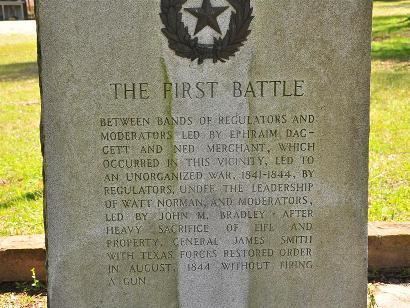Regulators Moderators Period 1839 – 1844 | Result Rebellion suppressed | |
 | ||
Charles W. JacksonCharles W. Moorman Edward MerchantJohn M. BradleyJames J. Cravens Similar Battleground Gunfight, Vaudeville Theater ambush, Skeleton Canyon shootout, Las Cuevas War, Wham Paymaster robbery | ||
The Regulator–Moderator War, or the Shelby County War, was a nineteenth century feud in East Texas during the Republic of Texas years between rival factions. The war started out as a dispute of land ownership before becoming a violent conflict for control of the local economy. Soon raids, livestock thievery, and murders erupted in the region and took the lives of over 40 men.
Contents
Background
The United States and Spain ignored a strip of land between Spanish Texas and the Louisiana Territory (in what is now the U.S. state of Louisiana), because they were unable to agree on the boundary and did not want to go to war over it. The area, known as the Sabine Free State or the Neutral Ground, developed into a lawless patch that neither country controlled. The lawlessness spilled over into the adjacent portion of East Texas, still under Spanish control. Even after Spain and the United States signed the Adams-Onís Treaty (1819) and Mexico gained its independence (1821), little changed in regards to the region. After Texas won its independence from Mexico, the land remained wild and lawless.
War
The Regulator–Moderator War was a land feud in Harrison and Shelby counties in East Texas from 1839 to 1844. The feud eventually involved Nacogdoches, San Augustine, and other East Texas counties.
The main leaders were Charles W. Jackson and Charles W. Moorman for the Regulators and Edward Merchant, John M. Bradley, and James J. Cravens for the Moderators. Their differences date back to land frauds, cattle rustling, barn burners, and revenge killings. Dozens had been killed over the years.
The conflict began over fraud, cattle rustling, and land swindling in the Neutral Ground, the lawless area between the American border and Mexican Texas. This conflict reached a boiling point after Charles W. Jackson, a former Mississippi riverboat captain and a fugitive from Louisiana justice, shot Joseph Goodbread at Shelbyville in 1840. Jackson soon organized a militia he named the Regulators to prevent "cattle rustling." In turn, the Moderators were organized by Edward Merchant to moderate the Regulators. When Charles Jackson went on trial on July 12, 1841, before Judge John M. Hansford, a friend of the Moderators and Goodbread, the Regulators intimidated the court so much that the trial could not proceed.
Open hostilities broke out, resulting in killings and house burnings. Jackson and a companion were later ambushed and killed by the Moderators, and Charles Moorman replaced Jackson as leader of the Shelby County Regulators. Moorman, who may have been wanted for forgery in Mississippi, led a party to avenge Jackson and Lauer. They surprised the assassins 25 miles (40 km) north of Crockett. The McFaddens were tried in Shelbyville in October 1841 for the Jackson-Lauer killing and were hanged with the exception of the youngest brother.
In the summer of 1844, the Moderators met at Bells Springs and renamed themselves the Reformers. They excluded Bradley and elected James J. Cravens as their leader. They determined to occupy Shelbyville. Republic of Texas president Sam Houston grew tired of the lawless fighting and attempted to settle the matter. He sent George W. Terrell to investigate the mayhem. Terrell wrote to Houston, "It really appears to me as if society were about to dissolve itself into its original elements."
On 14 August 1844 Houston ordered Travis G. Brooks and Alexander Horton to lead 500 militia into East Texas and make peace between the factions. Brooks was immediately arrested, held, but soon released. Exasperated, Houston rode to East Texas and set up headquarters the last two weeks in August at San Augustine to take charge. Through his diplomacy of fairness and even-handedness, Houston was able to get the factions to sign a peace treaty. The feuding groups signed a truce on July 24, 1844, which protected "good and unoffending citizens." Both factions put aside their differences during the Mexican-American War and joined together with Captain L.H. Mobitt's company.
Harrison County Sheriff John J. Kennedy and county judge Joseph U. Fields helped end the conflict siding with the law and order party.
